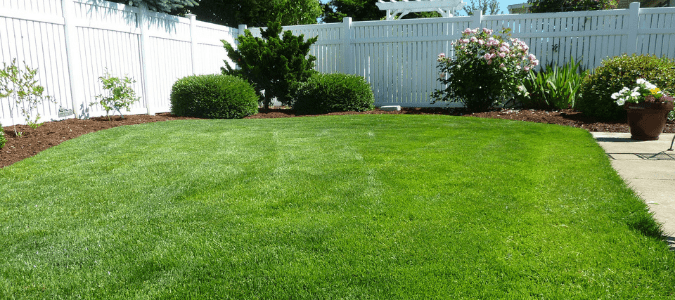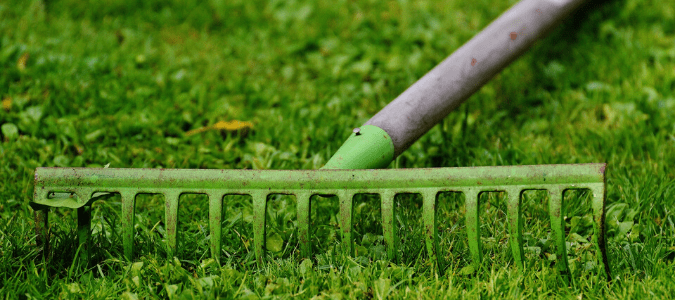The key to maintaining a healthy, vibrant and beautiful lawn is proper maintenance. That includes dethatching, aerating and overseeding your lawn at the right times. Many homeowners want to know if they can dethatch and aerate their lawns at the same time, and the answer is yes.
However, there is a particular order to follow for the best results. Keep reading for a step-by-step guide on how to dethatch and aerate your lawn so it looks beautiful all year.
Next, it’s highly recommended to aerate your lawn before overseeding. Overseeding is adding new seeds to your existing grass to fill bare patches or increase grass density. Aerating your lawn beforehand improves soil-to-seed contact, which helps the seeds germinate and develop strong root systems.
Finally, there are two categories of lawn aeration tools: spike and plug aerators, also known as core aerators. Figuring out which type is best for your lawn depends on your soil. Keep reading for a guide to tools to aerate a lawn.
If you have more questions about dethatching, aerating or overseeding your lawn, contact a lawn service specialist today.
Can You Dethatch and Aerate at the Same Time?
What is the difference between dethatching and aerating your lawn? Dethatching is when you remove the thatch from your lawn, which includes grass stems, roots and old blades that pile up between the surface of your soil and the grass blades.
Some amount of thatch is healthy; however, too much can cause problems. A thick layer of thatch can prevent fertilizer, water and other nutrients from penetrating into the soil. It can even act as a barrier that prevents air from getting into your grass’s roots.
Dethatching your lawn promotes healthy root growth, proper drainage and prevents disease. It also adds visual appeal to your lawn and makes your fertilizer more effective.
On the other hand, aerating is when you puncture your lawn with small holes. Lawn aerator machines, called aeration rollers, also pull out thatch. Aerating your lawn improves air circulation between the atmosphere and the soil. It gives your lawn more breathing room to absorb more fertilizer and water.
It is possible to dethatch and aerate your lawn at the same time; however, you should always dethatch first. Doing it in that order makes your aeration process more effective.
How to Dethatch Your Lawn
First, inspect your lawn and determine the thickness of your thatch. If the layer is at least half an inch thick, it’s time to dethatch.
It’s important that you dethatch your lawn at the right time so that your grass can recover. The best time is during your grass’s active growing season, which varies depending on the grass species. In general, cool-season grasses should be dethatched in early spring or fall, while warm-season grasses should be dethatched in late spring or early summer.
Follow these steps to dethatch your lawn:
- Mow your lawn and cut it slightly shorter than usual so that your dethatching equipment can reach the layer of thatch. However, be careful not to remove more than one-third of the leaf tissue at one time.
- Use a dethatching rake, vertical mower or power dethatcher to remove the layer of thatch. Follow the instructions on the equipment and set it for the correct level of thatch thickness.
- Rake up the loose thatch debris. You can add the debris to your compost bin or pile if it is not diseased.
How To Aerate Your Lawn
It’s also important to know when you should aerate your lawn. Specialists recommend aerating your lawn during your grass’s growing season, which is why you can aerate at the same time you dethatch your lawn. However, remember to dethatch your lawn first.
Follow these steps to aerate your lawn:
- Thoroughly water your lawn one or two days before you aerate. The moistness will allow your aeration device to penetrate more deeply.
- Aerate your lawn using a spike or core aerator. Make sure it reaches two or three inches deep into your soil. Find out which aerator tool is right for your lawn below.
- If you have heavily compacted soil, make a few more passes with the aerator.
- If you used a spike aerator, spread a thin layer of compost over the lawn.
- If you used a plug aerator, leave the soil plugs on your lawn and let them decompose on their own. You can use a rake to break them up or leave them as plugs.
Contact a lawn service specialist if you need help dethatching or aerating your lawn.
Do I Need To Aerate Before Overseeding?
It’s highly recommended that you aerate your lawn before overseeding. First, it enhances seed-to-soil contact. An aerated lawn contains open spaces in the soil so that the seeds can germinate and develop healthy root systems.
Next, it improves the seed’s nutrient intake. Aerating your lawn allows the soil to take in more nutrients from fertilizer, which is essential for strong new grass growth.
Aeration also increases water absorption and reduces runoff waste. Seeds need enough water to germinate, and aerating your lawn ensures that the water is evenly dispersed into the soil.
Finally, aerating your lawn before overseeding reduces soil compaction. It’s natural for soil to compact over time due to foot traffic, soil settling or machinery use. Aeration loosens the soil, which promotes root growth for the new seeds and allows for better oxygen circulation.
How To Overseed Your Lawn
After dethatching and aerating your lawn, the next step is overseeding. Overseeding is when you spread grass seed over your pre-existing lawn to fill in bare spots. It can also help increase the density of your grass and improve the overall appearance of your lawn.
Before you get started, inspect your lawn and identify the areas that require overseeding. Look for thin or patchy grass coverage, bare patches or weak turf.
Follow these steps to overseed your lawn:
- Mow your lawn shorter than usual to ensure proper seed-to-soil contact. However, do not cut off more than a third of the blades’ length.
- Aerate your lawn following the instructions above.
- Remove all debris and thatch from your lawn.
- Using a handheld spreader or a broadcast spreader, spread the seed over your lawn. Adjust the spreader to the seed manufacturer’s setting and make sure to distribute it evenly over your lawn.
- Water the lawn immediately after overseeding, and keep watering it frequently enough for the soil to remain moist until the new grass roots are established. Avoid heavy foot traffic over your lawn.
Contact a lawn service specialist today for help with aerating or overseeding your lawn.
What Are the Best Tools To Aerate a Lawn?
There are two main lawn aeration tools: the spike aerator and the plug aerator. Various factors will determine which type of tool is best for your lawn.
For example, spike aerators are more effective for lightly compacted soils. To use a spike aerator, you either push or walk behind it as you roll it over your lawn. As it rolls, the spikes will punch holes two to three inches deep in your lawn.
It’s important to adequately aerate your lawn without causing too much stress on your turf. Properly spacing out the aeration holes is key. If you’re using a spike aerator, the holes should be between two and four inches apart.
After using the spike aerator, spreading a thin layer of topdressing or compost will help fill in the holes and improve the overall health of your soil.
For lawns with heavily compacted soil, foot traffic damage or significant thatch buildup, a plug aerator is the best choice. These tools are also known as core aerators. Instead of puncturing holes into the soil, they remove small plugs of soil that are two to three inches long. They are highly effective and are often used to bring dead grass back to life.
There are several types of plug aerators, including walk-behind and ride-on versions. Ride-on versions are more convenient for larger lawns. With a plug aerator, it’s important to space the holes between four and six inches apart so you don’t overstress the turf.
After you aerate your lawn with a plug aerator, you can leave the plugs on your grass and let them naturally decompose. They will feed your lawn beneficial nutrients and save you the hassle of cleaning them up.
If you aren’t sure which type of aeration tool is right for your lawn, call a lawn service specialist today. They can inspect your lawn and give you tips or take care of the job themselves.
Achieve a Beautiful Lawn With Proper Maintenance
Proper lawn maintenance is the key to achieving a lush and healthy lawn. The first step is dethatching your lawn, which removes the layer of old grass blades, stems and roots from your lawn and improves airflow to the soil.
Next, aerate your lawn using a spike or plug aerator. Aerating improves water absorption, soil intake, oxygen circulation, root development and more.
Finally, fill in bare patches by overseeding your lawn. Make sure you keep your lawn moist so that the seeds can develop root systems.
For more lawn maintenance tips and help, contact a lawn service specialist.
ABC Can Care For Your Lawn
Lawn dethatching and aeration can be tricky if you don’t have the right tools and, without the proper experience, you can spend a long time and unknowingly damage your grass. Instead of taking that chance, let the lawn service professionals at ABC Home & Commercial Services take lawn aeration and dethatching off your plate. Not only can we help with this chore, but we can also take over your lawn mowing, fertilizing and watering so you can spend more time enjoying your yard as opposed to working on it.



